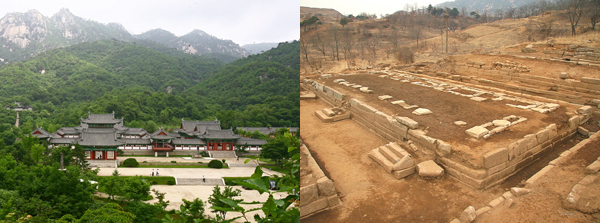North Korea looks to include Kaesong on Unesco list of cultural heritage sites

The Manwoldae (left), ruins of a vast 10th-century royal palace built in the Goryeo Dynasty, and the Yeongtong Temple (right) are just two of the cultural sites in the historic city of Kaesong that North Korea is aiming to include on the Unesco’s World Heritage list. [YONHAP]
Kaesong, a North Korean city just 45 miles north of Seoul, has been the setting for a number of historic events on the peninsula.
It was the capital of the Goryeo Dynasty (918-1392). It is where South and North Korean officials meet occasionally to discuss issues like food aid and the North’s nuclear program. It is also where the two Koreas set up a joint industrial complex in an attempt to improve soured relations.
Various reports last week, quoting sources in Unesco’s World Heritage Committee and Korea’s Cultural Heritage Administration, said North Korea is seeking to include the historic monuments and sites in Kaesong on Unesco’s World Heritage list.
The World Heritage Committee is currently meeting in St. Petersburg, Russia, to consider the inclusion of 33 sites on the World Heritage list, one of which is Kaesong. The meeting ends on July 6, but the decision on inscription won’t be released until the summer of 2013.
“An advisory body to Unesco called Icomos will conduct an inspection of the site between July and October of this year, and based on the evaluation of the inspection, the World Heritage Committee will make its final decision during the 37th session between late June and early July next year,” said Han Jun-hee, an official at the Cultural Heritage Administration. “Until then, we won’t know the details about this ‘Historic Monuments and Sites in Kaesong.’?”
Many historians and policy makers speculate that the proposed site includes the Manwoldae, the excavated ruins of a vast 10th-century royal palace in Goryeo; the tombs of the Goryeo kings; the Yeongtong and Pyochung temples; and possibly the Sungkyunkwan, a former Confucian educational institute.
Today, Kaesong, located at the center of the Korean Peninsula and known for its high-quality ginseng, is a large city with a population of about 380,000.
Manwoldae is located next to the modern city of Kaesong, and since 2007 South and North Korean archaeologists have been conducting a joint excavation in the area.
In addition, in an effort to conserve not only the palace complex but also the area around it, the North Korean government has designated the traditional hanok, or traditional Korean homes, around the palace for historic preservation.
This isn’t the first time North Korea has sought Unesco World Heritage status for the city. North Korea submitted an application last year, but didn’t make it to the review due to the lack of necessary documents.
Currently, the only North Korean site in Unesco’s Cultural Heritage list is the complex of the tombs from the Goguryeo Dynasty (37 BC - AD 668).
The Goguryeo were known for their military prowess and covered a massive territory that included not only today’s North Korea, but also southern Manchuria and southeastern Russia.
Other sites vying for Unesco’s Cultural Heritage status include Mount Fuji, the highest mountain in Japan; the historic city of Kamakura, south of Tokyo; and the terraced fields in Honghe Prefecture, Yunnan Province, China.
By Kim Hyung-eun [hkim@joongang.co.kr]










with the Korea JoongAng Daily
To write comments, please log in to one of the accounts.
Standards Board Policy (0/250자)